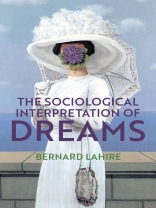For Freud, dreams were the royal road to the unconscious: through the process of interpretation, the manifest and sometimes bewildering content of dreams can be traced back to the unconscious representations underlying it. But can we understand dreams in another way by considering how the unconscious is structured by our social experiences?
This is hypothesis that underlies this highly original book by Bernard Lahire, who argues that dreams can be interpreted sociologically by seeing the dream as a nocturnal form of self-to-self communication. Lahire rejects Freud’s view that the manifest dream content is the result of a process of censorship: as a form of self-to-self communication, the dream is the symbolic arena most completely freed from all forms of censorship. In Lahire’s view, the dream is a message which can be understood only by relating it to the social world of the dreamer, and in particular to the problems that concern him or her during waking life. As a form of self-to-self communication, the dream is an intimate private diary, providing us with the elements of a profound and subtle understanding of who and what we are. Studying dreams enables us to discover our most deep-seated and hidden preoccupations, and to understand the thought processes that operate within us, beyond the reach of our volition.
The study of dreams and dreaming has largely been the preserve of psychoanalysis, psychology and neuroscience. By showing how dreams are connected to the lived experience of individuals in the social world, this highly original book puts dreams and dreaming at the heart of the social sciences. It will be of great value to students and scholars in sociology, psychology and psychoanalysis and to anyone interested in the nature and meaning of dreams.
Daftar Isi
Table of Contents
Acknowledgements
Introduction: A dream for the social sciences
1. Advances in the science of dreams
The dream before Freud
The need for an integrative theory
Scientific progress and relativism
The art of limping: the end of pure speculation
On the scientific interpretation of dreams
Beyond Freud
2. The dream: an intrinsically social individual reality
Can the social be absorbed into the cerebral?
A few precedents in the social sciences
Limitations of environmentalist approaches: the ecology of dreams
Limitations of literal approaches: content analysis of dream accounts
In what sense are dreams a social issue?
A general formula for the interpretation of dreams
3. Psychoanalysis and the social sciences
Between biological and social
Psychoanalysis and the general formula for interpreting practices
Infantile hypothesis
Sexual hypothesis
The highs and lows of the dream: sexuality and domination
4. Incorporated past and the unconscious
Ways in which the incorporated past is actualized
The statistician brain or practical anticipation
The internalization of the regularities of experience
Oneiric schemas and the incorporated past
A critique of the event-focused approach
5. Unconscious and involuntary consciousness
The involuntary consciousness of the dreamer
Unconsciousness or involuntary consciousness
The unconscious without repression
6. Formal censorship, moral censorship: the double relaxation
The most private of the private: on stage and behind the scenes
All dreams are not the fulfillment of an unsatisfied wish
7. The existential situation and dreams
Dream and outside the dream
The driving force of emotions
The therapeutic and political effects of making problems explicit
8. Triggering events
The day residue: theoretical and methodological inaccuracies
The day residue: the inertia of habit
The deferred effects of triggering events
Nocturnal perceptions and sensations
9. The context of sleep
Cerebral and psychic constraints
Withdrawing from the flow of interactions
Self-to-self communication: internal language, formal and implicit relaxation
10. The fundamental forms of psychic life
Practical analogy
Analogy in dreams
Transference in analysis as analogical transference
Association: analogy and contiguity
11. The oneiric processes
Verbal language, symbolic capacity and dream images
Visualization
Dramatization-exaggeration
Personal or universal symbolization
Metaphor
Condensation
Inversions, opposites, contradictions
12. Variations in forms of expression
An expressive continuum
Forms of expression, forms of psychic activity and types of social context
The false ‘free expression’ of dreams and the varying levels of contextual constraints
The dream between assimilation and accommodation
The dream, as opposed to literature
Play and the dream
Dreams and daydreams
Psychoanalytic therapy: recreating the conditions of the dream
13. Elements of methodology for a sociology of dreams
The fleeting nature of dreams and dream accounts
Do we need to know the dreamers to understand their dreams?
Access to the non-dream state: associations
Beyond associations
Access to the non-dream state: the sociological biography
Clarifications, associations, partial or systematic biographical accounts
Conclusion 1. A dream without any function
Conclusion 2. Dreams, will and freedom
Coda. The formula for interpreting practices – implications and challenges
Bibliography
Index
Tentang Penulis
Bernard Lahire is Professor of Sociology at the École Normale Superieure de Lyon. He has published over twenty books, including This is Not a Painting and The Plural Actor.












